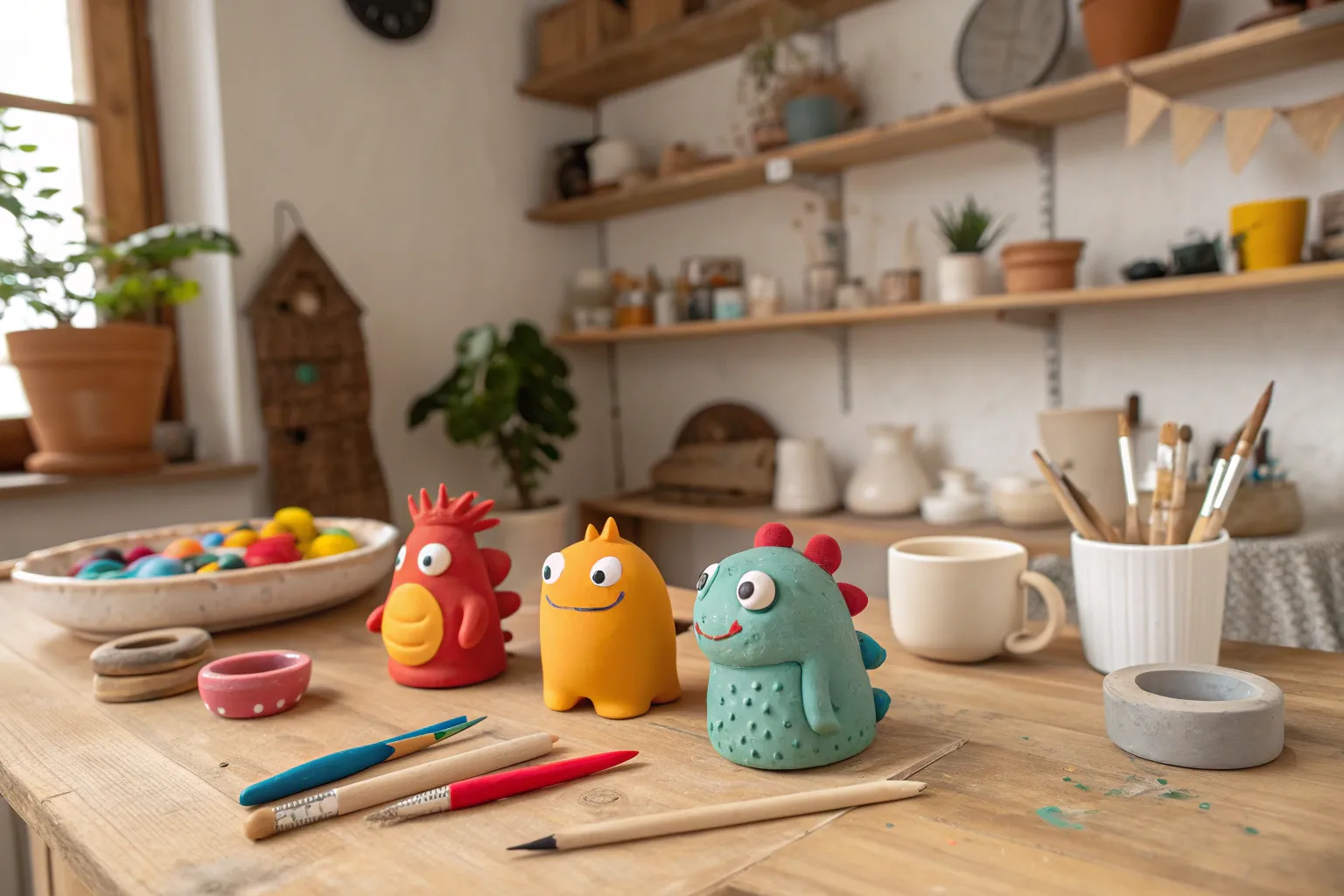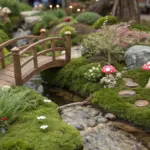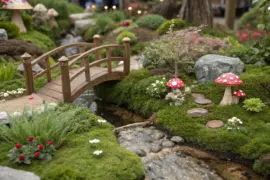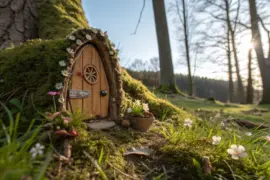The magic begins when your fingers first meet the cool clay and you realize that within this simple material lives a world of tiny beings waiting to be awakened. In my years of crafting fairy worlds and miniature scenes, I’ve discovered that the most enchanting creatures often spring from the simplest techniques.
Gathering Your Materials

Creating miniature companions requires surprisingly few materials, making this craft accessible and budget-friendly for families. The heart of your toolkit starts with polymer clay—this magical medium stays soft until baked, giving you all the time needed to perfect each tiny detail. Unlike air-dry clay that can crack as it hardens, polymer clay maintains its flexibility and bonds beautifully to itself.
Essential Clay Colors:
- Earthy tones: brown, tan, and beige for woodland creatures
- Bright primaries: red, blue, yellow for fantasy beings
- White and black for mixing and detailing
- Translucent clay for fairy wings and magical effects
Simple Tools from Your Kitchen:
- Toothpicks for tiny details and textures
- Butter knives for cutting and scoring
- Spoons for smooth curves
- Forks for creating fur textures
- Cotton swabs for blending and smoothing
The beauty of hand sculpting lies in using what you already have. I often reach for everything from ballpoint pens for eye indentations to plastic bottle caps for perfect circles.
Preparing Your Clay
Conditioning is the secret first step that transforms stiff clay into a pliable medium perfect for tiny hands. Warm the clay between your palms, then knead and stretch it for about five minutes. You’ll know it’s ready when it feels smooth and responds easily to gentle pressure.
For children, I recommend starting with softer clay brands like Sculpey Bake Shop or Sculpey III, which condition more easily than firmer varieties. These clays hold their shape well while remaining forgiving for beginners.
Building Your First Creature
Starting with Simple Shapes

Every magical creature begins with basic geometric forms. A sphere becomes a hedgehog’s body, an oval transforms into a dragon’s egg, and a teardrop creates the perfect bird shape. This approach builds confidence while teaching fundamental sculpting principles.
The Classic Approach:
1. Roll your main body shape between your palms
2. Gently pinch and pull small sections for legs and arms
3. Add a smaller ball for the head
4. Press pieces together firmly, blending the seams with gentle finger pressure
Creating Woodland Friends

For a Simple Rabbit:
Begin with a gray clay ball for the body, then add a smaller sphere for the head. Roll tiny logs for ears, cutting each in half and adding a pink center strip. The key to charm lies in the proportions—make the head slightly oversized for that endearing, youthful appearance that children love.
For a Tiny Dragon:
Start with a tapered log shape, one end pointed for the tail, the other flattened for head attachment. Bend the neck upward and curl the tail tip for personality. Small teardrop shapes become wings when flattened and textured with a toothpick.
Adding Life Through Details
Expressive Features
The face brings your creature to life. Use a ballpoint pen to create gentle eye sockets, then fill with tiny clay balls. For sleepy, contented expressions, roll very thin black clay snakes and carefully place them as closed eye lines—this technique creates an especially peaceful, child-friendly appearance.
Creating Personality:
- Gentle indentations with a cotton swab for nostrils
- Tiny triangles of contrasting clay for noses
- Curved lines drawn with a toothpick for smiling mouths
Texture and Movement
Transform smooth surfaces into believable creatures through simple texturing techniques. Tap gently with a textured surface—even bubble wrap creates beautiful scale patterns. For fur effects, use a fork to create tiny parallel lines, then soften them with light finger brushing.
Wings deserve special attention in miniature work. Roll clay thin, cut wing shapes, then use a toothpick to draw delicate vein patterns. For fairy wings, translucent clay creates an ethereal, magical quality.
Building Magical Scenes

Creating Habitats
Once you’ve mastered individual creatures, scene-building multiplies the magic. A simple clay base becomes a fairy ring when dotted with tiny mushrooms. Each mushroom requires only a small white stem topped with a red cap dotted with white spots.
Miniature Garden Elements:
- Roll green clay into tiny balls, then pinch them into leaf shapes
- Create flowers by flattening small clay circles and gathering them around a center
- Build tiny stepping stones from flattened gray clay ovals
Scale and Proportion
Working in miniature teaches important lessons about relative sizing. In fairy worlds, creatures often exist at different scales—a tiny dragon might be no larger than a butterfly, while a fairy mouse could be the size of your thumb. This creative freedom allows children to explore proportion while building their own enchanted rules.
The Baking Process

Baking transforms your soft creations into permanent keepsakes. Preheat your oven to the temperature specified on your clay package—typically 275°F (130°C). Place creatures on a parchment-lined baking sheet, ensuring they don’t touch.
Timing Guidelines:
- Very small pieces (under 1/4 inch thick): 15-20 minutes
- Standard miniatures: 30 minutes
- Thicker sculptures: 30 minutes per 1/4 inch of thickness
Safety note: Always supervise children during the baking process, and ensure good ventilation. The clay may darken slightly—this is normal and often adds to the charm of handmade pieces.
Bringing Characters to Life
Color and Finishing
After cooling completely, your creatures can be painted with acrylic paints for added detail. A light wash of brown paint, then wiped away, creates beautiful aging effects. For magical touches, dry brush tiny amounts of metallic paint on wings or scales.
Simple finishing techniques:
- Seal with matte varnish for protection
- Add glitter while paint is still wet for fairy magic
- Use fine-tipped markers for precise facial features
Storytelling Through Clay
Each tiny creature carries the potential for stories. I encourage families to create character backgrounds together—where does this dragon live? What does the fairy eat for breakfast? These questions spark imagination while building emotional connections to the handmade pieces.
Display ideas that extend the magic:
- Create seasonal scenes that change throughout the year
- Build tiny shelves or shadow boxes for creature homes
- Photograph creatures in outdoor settings for magical realism
Advanced Techniques for Growing Skills
Armature Building
As skills develop, wire armatures allow for more dynamic poses. Wrap thin craft wire in aluminum foil, then cover with clay. This technique enables creatures with outstretched wings or dancing poses that would be impossible with clay alone.
Mixed Media Magic
Combine clay creatures with natural materials for enhanced realism. Tiny twigs become fairy wands, acorn caps transform into hats, and dried flower petals create realistic wings. This approach teaches children to see creative potential in everyday objects.
The journey of creating miniature companions builds more than just motor skills—it develops patience, planning abilities, and creative problem-solving. Each tiny creature represents hours of focused attention and careful work, creating tangible proof of growing artistic abilities.
Most importantly, these little beings become treasured friends, carrying the magic of their creation into imaginative play and storytelling adventures. In a world of digital entertainment, the simple act of shaping clay by hand offers something irreplaceable—the satisfaction of creating something beautiful and entirely your own.
Whether your creatures inhabit fairy gardens, bookshelf displays, or simply live in small hands during imaginative play, they carry forward the ancient human tradition of creating companions from earth and imagination. The magic lies not just in the finished pieces, but in the quiet moments of creation, where time slows down and possibilities take shape beneath gentle fingers.






